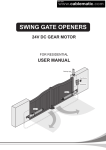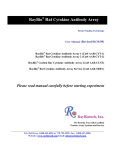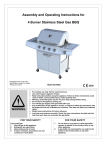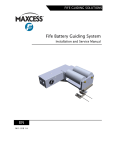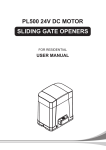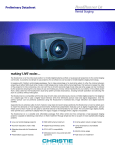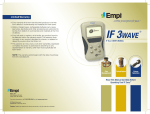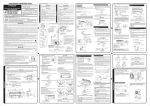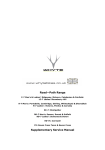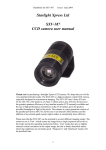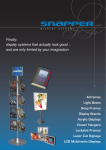Download USER MANUAL
Transcript
F330 SWING GATE OPENERS 24V DC GEAR MOTOR FOR RESIDENTIAL USER MANUAL Flashing Light Push Button Control box Gate 2 Gate 1 ߆ԇࢽি400-820-3735 ৠ֭www.fabetgroup.com Index 1. Warnings 2 4.2 SW2 Dip Switch Setting 19 2. Product Description 3 4.2.1 Electric Latch Adjustment (Dip 5.Latch) 19 2.1 Applications 3 4.2.2 Slowdown Speed Adjustment of 2.2 Description of The Automation 2.3 Description of Devices 3 3 2.3.1 F330 Electromechanical 4 2.3.2 PC200 Control Box 2.3.3 PH-1 Photocells 4 4 2.3.4 PR-1 Radio Transmitter 2.3.5 PF-1 Flashing Light 2.3.6 PKS-1 Key Selector 2.3.7 PPB-1 Push Button 2.3.8 PEL-1 Electric Latch and PS-1 Stopper 3. Installation 3.1 Notes of Motors in Operation 3.1.1 Tools in Installing 3.1.2 Motors, Components and Its Installation 3.2 Power Connection 3.2.1 Notes for Power Connection 3.3 Installation 3.3.1 Preparation for Motor Installation 3.3.2 Installation of The Gear Motors 3.3.3 PKS-1 Key Selector 3.3.4 PPB-1 Push Button 3.3.5 PF-1 Flashing Light 3.3.6 PH-1 Photocells 3.3.7 PEL-1 Electric Latch and PS-1 Stopper 3.3.8 PC200 Control Box 4. Dip Switch Setting 4.1 SW1 Dip Switch Setting 4.1.1 Slowdown Adjustment (Dip 1.S/F Set) 4.1.2 Over-current Adjustment (Dip 2.Over2 & Dip 3.Over1) 4.1.3 4.2.3 4.2.4 19 Operation Speed Adjustment of The Gear Motors (Dip 7.Fast) Gear Motors in Illustration The Gear Motors (Dip 6.Slow) 19 Single and Dual Gate Operation Adjustment (Dip 8.Ds/Set) 19 4.3 LED Indication 20 4 5 5 5 5 4.4 Transmitter Memorizing and Erasing Process 20 4.5 System Learning Process 4.6 Gate Operation 4.7 Gate-moving Logic 4.8 Advanced Operation of the Transmitter 21 21 21 21 5 5 6 5. Trouble Shooting 22 6. Technical Characteristics 6.1 F330 6.2 PC200 Control Box 6.3 PH-1 Photocells 6.4 PKS-1 Key Selector 6.5 PPB-1 Push Button 6.6 PF-1 Flashing Light 6.7 PR-1 Transmitter 6.8 PEL-1 Electric Latch 23 23 23 23 23 23 23 24 24 7. Annexes 7.1 CE Declaration of Conformity 6 6 6 7 7 9 11 12 12 25 25 13 14 16 18 18 18 18 Gate Auto-close Adjustment (Dip 4.Auto 3, Dip 5.Auto 2 & Dip 6.Auto 1) 4.1.4 Photocells Adjustment (Dip 7.Photo) 4.1.5 Flashing Light Adjustment (Dip 8.Light) 19 19 19 INSTRUCTIONS F330 1 1) Warnings Please read this instruction manual carefully before the installation of gate-automated system. Do not make any modifications to any components except that it is mentioned in this manual. This manual is exclusively for qualified installation personnel. Is not responsible for improper installation and failure to comply with local electrical and building regulations. Do not try to manually open or close the gates before you release the gear motor. Keep all the components of F330 system and this manual for further consultation. In this manual, please pay extra attention to the contents marked by the symbol: If there is a failure that cannot be solved and is not mentioned in this manual, please contact qualified installation personnel. Do not use the gate-automated system before all the procedures and instructions have been carried out and thoroughly read. Test the gate-automated system weekly and have qualified installation personnel to check and maintain the system at least every 6-month. Be aware of the hazards that may exist in the procedures of installation and operation of the gate-automated system. Besides, the installation must be carried out in conformity with local standards and regulations. If the system is correctly installed and used following all the standards and regulations, it will ensure a high degree of safety. Make sure that the gates works properly before installing the gate-automated system and confirm the gates are appropriate for the application. Do not let children operate gate-automated system. or play with the Do not cross the path of the gate-automated system when operating. Please keep all the control devices and any other pulse generator away from children to avoid the gate-automated system being activated accidentally. 2 INSTRUCTIONS F330 Install warning signs (if necessary) on the both sides of the gate to warn the people in the area of potential hazards. 2) Product Description and Applications 2.1 Applications F330 is applied for residential automation of single or dual leaf gate. F330 has to be operated with electricity and it’s forbidden to be operated by back-up batteries for normal use. Back-up batteries are only allowed for emergent operation when there is a power failure, and the gear motors can be released by special keys to move the gate manually. 2.2 Description of the Automation The following diagram of F330 typical installation describes some terms and accessories of a gate automation system: G E Figure 1 H F C I A A J 2.3 Description of Devices F330 includes the accessories shown in Figure 2. Please check the accessories the same as the package provided. Attention: Some accessories of F330 are not included due to local regulations or customized order. A) 2 F330 electromechanical gear motors with mounting brackets. Figure 2 B) 2 release keys. C) 1 pair of PH-1photocells.(one TX and one RX) C D B D) 2 PR-1 radio transmitters. E) 1 PKS-1 key selector with two keys. F) 1 PPB-1 push button switch. G) 1 PF-1 flashing light. A E F H) 1 Control box I) 1 PEL-1 electric latch. J) 1 PS-1 stopper. K) Various small parts: bolts, nuts, etc. See Tables 1, 2, 3, 4, 5, 6. I G H INSTRUCTIONS F330 J K 3 2.3.1 F330 Electromechanical Gear Motors Figure 3 F330 consists of a worm screw reduction gear and a 24V direct current motor. The gear motor could be released manually by special release keys when there is a power failure. 1)F330 The gear motor is installed with two post brackets, one rear plate and one front plate for the installation. Table 1: List of small parts F330 Front bracket 2pcs Front plate 2pcs Rear plate 2pcs Post bracket 4pcs M8*25L hex bolt 4pcs M8 self-locking nut 4pcs M12 *25L hex bolt 2pcs M12 self-locking nut 2pcs Release key 2pcs 2)Release Key 2.3.2 Control Box Control box consists of one control panel with incorporated receiver, one transformer and two back-up batteries. Provides the complete automation of the gear motors and other accessories of F330 kit. To connect separate terminals on the control panel and activate the gear motors and other accessories, the installation manual has to be carefully read beforehand. Table 2: List of small parts for Control Box Figure 4 Quantity 5*30 Screw 4 pcs Nylon screw anchor 4 pcs Figure 5 2.3.3 PH-1 Photocells The pair of PH-1 photocells has to be installed on the wall and connected to the control panel. The function of the photocells is to detect the obstacles found on the optical axis between the transmitter (TX) and the receiver (RX). TX 2.3.4 PR-1 Radio Transmitter PR-1 radio transmitter is used for the remote control of the gate movement. To use the transmitter, press and hold the button for 1 second. There are two buttons on the transmitter and (A) button is “open-stop-close mode” and (B) button is “pedestrian mode”. 4 INSTRUCTIONS F330 RX Figure 6 2.3.5 PF-1 Flashing Light Figure 7 PF-1 flashing light is controlled by control box and blinks when the gate is moving. The flashing light stops blinking when the gates finish opening or closing. Table 2: List of small parts for PF-1 Quantity 3*20 Screw 3 pcs Nylon screw anchor 3 pcs 2.3.6 PKS-1 Key selector The PKS-1 key selector is used for opening the gate outdoors without the radio transmitter. PKS-1 key selector is supplied with two keys Table 3: List of small parts for PKS-1 Figure 8 Quantity 3*20 Screw 3 pcs Nylon screw anchor 3 pcs Keys 2 pcs 2.3.7 PPB-1 Push Button Figure 9 The PPB-1 push button is used for opening the gate indoors without the radio transmitter. Table 4: List of small parts for PPB-1 Quantity 3*20 Screw 3 pcs Nylon screw anchor 3 pcs 2.3.8 PEL-1 Electric Latch and PS-1 Stopper Figure 10 PEL-1 electric latch is used to lock the gate and it has to be used with PS-1 stopper and installed on the master gate. Table 6: List of small parts for PEL-1 and PS-1 Quantity M8*25L hex bolt 3 pcs M8 self-locking nut Key 3 pcs 2 pcs 3) Installation: 3.1 Notes of Motors in Operation The F330 gate openers are applicable to per leaf of 4.0 meters in width and 350 kg in weight which can be opened up to 120 degrees primarily for residential use; where the performance shall be influenced by the factors such as gate dimension, weight and climate that the driven torque is necessarily to be adjusted properly. INSTRUCTIONS F330 5 3.1.1 Tools in Installing Please make sure all tools and cables are ready and conform to the industrial safety standard before installation. Please refer to Figure 11. Figure 11 3.1.2 Motors, Components and Its Installation in Illustration The installation procedure of F330 may be changed due to various accessories and quantities installed. The basic wiring diagram is shown in Figure 12. No wiring cables for accessories are supplied with KIT F330. Figure 12 3.2 Power Connection F330 comes with two power cables of 2m and 7m long, which requires very low voltage that no professionally trained personnel is required in installation; however, the users are advised to read the installation manual carefully before going for it. After getting to know all accessories and their positions, suggest starting from cable conduit arrangement to prevent the cables from being broken or damaged. 3.2.1 Notes for Power Connection 1. The installation of power supply cable to the motor should be carried out by a qualified professional electrician. 2. The power supply cable of the motor should be equipped with short circuit protection and leakage protection. Please make sure to shut off the power before going installation or maintenance. 6 INSTRUCTIONS F330 3.3 Installation 3.3.1 Preparation for Motor Installation F330 is not applicable to a gate which is inefficient or unsafe, neither to solve the defects due to incorrect installation nor poor maintenance. Check the following items before going for installation: 1). Make sure the weight and dimensions of the gate conform to the operation range of F330. Don’t use F330 if the gate specifications do not meet the requirements. 2). Make sure the gate structure conform to the criteria of automatic operation and force regulations. 3). Make sure there is no serious friction existing in the opening or closing travel of the gate leaves. 4). Make sure the gate is at horizontal level that the gate will not move aside at any position. 5). Make sure the gate can bear the impact of the motor torque when it is installed on any hole of the bracket which the surface is sufficiently sturdy. 6). Make sure the photo sensors are installed on flat surfaces to ensure the two ends of receiving and transmitting corresponded to each other. 7). Check the dimensions of the motors as below. Figure 13 F330 8). Make sure to leave enough space when the gate is opening. Figure 14 F330 150mm(Max) Min 150mm INSTRUCTIONS F330 7 9). If the gate is OPENED OUTWARD, please leave at least 70mm between the post brackets and the gate. Figure 15 (Aerial View) Min 70mm F330 Figure 16 (Aerial View) F330 10) . Using the leaf-opening angle as criteria to make sure all criteria in Figure 17 can be met. Figure 17 11). “C” value is 139mm. 12). “D” can be measured from the gate easily. 13). “A” = “C” + “D” 14). The value of “B” can be calculated from the value of “A” and the leaves opening angle. Ex. If “A”=160mm with the leaves opening angle of 100 degrees, then the value of “B” is approximate 190mm. **Please make sure “B” and “A” are similar or the same in value that the leaves can be operated smoothly, also to reduce the burden of the motor. 8 INSTRUCTIONS F330 3.3.2 Installation of The Gear Motors 1. Choose the correct dimensions of the motors and position to be installed. 2. Check if the mounting surface the brackets to be installed is smooth, vertical and rigid. 3. Arrange the cable conduit for power supply cable of the motors. 4. In order to obtain the optimal supporting from the rear plate, please assemble two post brackets and one rear metal plate according to Figure 18. 5. Loosen the two screws and remove the back cover of the motor as shown in Figure 19. 6. Place the leaves in the closed position. Figure 20 Figure 19 139 Figure 18 7. Refer to the distance of “B” in Figure 17, place the rear plate in the correct position on the mounting surface. Inspect if the distance is proper as shown in Figure 23 i.e. the position the front plate of the motor to be installed. 8. Place two post brackets on the surface to be installed and mark the drilling points, then drill minimum diameter of 8mm holes by four on the mounting surface to be installed and fasten up the brackets with screws and washers. 9. Please make sure the front plate is completely installed horizontally. Figure 22 Figure 21 10. Refer to Figure 23, the distance between front plate of the motor and rear plate is 798mm (F330), the difference in height is 2.5mm (F330). Figure 23 43mm 22.5mm Figure 24 798mm 11. Clamp and fix the motor front plate on the door temporarily. INSTRUCTIONS F330 9 12. Lift up the motor and insert the screws into the front plate. 13. Open the gear motor cover and release the screw, then take out the bolt as below Figure25. Lift the motor overhead and push the gate to the end until the screw holes of the motor end matches the holes on the rear plate as shown in Figure 25.1 and fasten the motor to the rear plate with bolt and screw as shown in Figure25.2. 3 1 Figure 25 Figure 25.1 Figure 25.2 1 3 2 2 14. Fasten the nut tightly and loosen it for half round for motor supporting in rotating. 15. Fasten the motor front end to the front plate with the bolt (A) and nut (B) tightly. Fully tighten the screw. 21. Connect the motor power cable as shown in Figure27. 22. Close the gear motor cover by tightening the two screws as shown in Figure28. Figure 27 Figure 26 White(+) Yellow(-) Hall sensor Red(5V) Hall sensor Green(Signal) Hall sensor Black(GND) A Motor B Figure 28 23. Gear Motor Release 1) Turn the round plate on the release part to “OPEN” position. See Figure 29. 2) Push out the release part to the end. See Figure 30. 3) Use the release key to turn the pin anti-clockwise to the end. See Figure 31. Figure 29 10 INSTRUCTIONS F330 Figure 30 Figure 31 3.3.3 PKS-1 Key Selector 1). PKS-1 key selector is installed outside and close to the gate at the height of about 100cm, so that it could be used by most people. Decide the installation position of PKS-1 first. See Figure 3.3.3 (1). 2). Remove the round cover (A) by prizing it out with a screwdriver. See Figure 3.3.3 (2). 3). Unscrew the two screws beside the lock body. See Figure 3.3.3 (3). 4). Turn the key and separate the bottom of the shell with the lock body. See Figure 3.3.3 (4). Figure 3.3.3 (1) 1000mm Figure 3.3.3 (2) Figure 3.3.3 (3) A Figure 3.3.3 (4) 5). Breach the three holes at the bottom and mark the points by the holes as reference. 6). Drill the holes in the wall and fix the bottom to the wall by three screws. See Figure 3.3.3 (5). 7). Connect the electric wires to the terminals as shown in Figure 3.3.3(6), and it’s not required to distinguish any polarity. The terminals can be removed for connecting the wires easily. 8). Turn the key and insert the shell on the bottom. Turn the key back to the center position and the shell will be fixed to the bottom. 9). Tighten the lock body with the two screws and insert the round cover by pressing it to attach to the whole unit. Figure 3.3.3 (5) Figure 3.3.3 (6) INSTRUCTIONS F330 11 3.3.4 PPB-1 Push Button 1). PPB-1 push button is installed indoors at the height of about 100cm, so that it could be used by most people. 2). Remove the round cover (A) by prizing it out with a screwdriver. See Figure 3.3.4 (1). 3). Unscrew the two screws beside the button. 4). Separate the upper shell with the bottom. See Figure 3.3.4 (2). 5). Breach the three holes at the bottom and mark the points by the holes as reference. 6). Drill the holes in the wall and fix the bottom to the wall by three screws. See Figure 3.3.4 (3). 7). Connect the electric wires to the terminals as shown in Figure 3.3.4 (4), and it’s not required to distinguish any polarity. The terminals can be removed for connecting the wires easily. 8). Attach the upper shell to the bottom and screw them up by two screws and insert the round cover by pressing it to attach to the whole unit. Figure 3.3.4 (1) A Figure 3.3.4 (3) Figure 3.3.4 (4) 3.3.5 PF-1 Flashing Light 1). Decide the installation position of the flashing light. The flashing light has to be installed near the gate and easy to be seen by users and passersby. The flashing light can be installed horizontally or vertically. See Figure 3.3.5 (1). 2). Unscrew the four screws on the light base and separate the base with the bottom as shown in Figure 3.3.5 (2). 3.) Connect the wires and penetrate the wires into the hole of the base. See Figure 3.3.5 (3). 4.) Drill the holes in the wall and fix the bottom to the wall by three screws. See Figure 3.3.5 (4). Figure 3.3.5 (1) 12 INSTRUCTIONS F330 Figure 3.3.5 (2) Figure 3.3.5 (3) Figure 3.3.5 (4) 5). Connect the four wires of the light and the antenna to the PCB terminals and place the wires into the conduit if necessary. See Figure 3.3.5 (5). 6). Tighten the four screws back on the light base. Figure 3.3.5 (6) 7). Replacing the bulb set. See Figure 3.3.5 (7) 7.1) Unscrew the flashing light wires from the PCB terminals and make sure the power of the light is off. 7.2) Release the three screws (A)、(B)、(C) of the flashing light cover. 7.3) Separate the flashing light cover and replace the bulb set with a new one. 7.4) Tighten the three screws (A)、(B)、(C) of the flashing light cover. A C B Figure 3.3.5 (5) Figure 3.3.5 (6) Figure 3.3.5 (7) 3.3.6 PH-1 Photocells 1). Decide the installation position of the photocells. See Figure 3.3.6 (1). 2). Unscrew the screws and secure the photocells on the post A, B or C. See Figure 3.3.6 (2) and (3). Figure 3.3.6 (1) Figure 3.3.6 (2) Figure 3.3.6 (3) B A C 3). Wiring connection: TX: Connect terminals 1 and 2 on the transmitter with the terminals GND and 24V on the PC200 PCB. RX: Connect terminals 1, 2 and 4 on the receiver with the terminals GND, 24V and phot1 on the PC200 PCB. And use an extra wire to connect terminals 2 and 5 on the receiver as a bridge. See Figure 3.3.6 (4) Figure 3.3.6 (5) and Figure 3.3.8 (5) Figure 3.3.6 (5) Transmitter Figure 3.3.6 (4) CA CC 1 2 NA NC C 3 4 5 O R I Z V E R T V E R T CA CC NA: Normal Open NC: Normal Close : DC(+) Input Voltage : DC(-) Input Voltage C: Common CA: AC(12~24) CC: DC(12~24) VERT:Vertical ORIZ:Horizontal Receiver NA NC 1 2 3 4 C 5 O R I Z Power LED: Green CA CC NA NC 1 2 3 4 C 5 O R I Z Vertical Adjustment Horizontal Adjustment LED:Red(Beam Alignment) INSTRUCTIONS F330 13 3.3.7 PEL-1 Electric Latch and PS-1 Stopper 1. Stopper: 1). Before installing the stopper, please make sure the gates are in close positions and the surface to be installed is flat. 2). Place the stopper on the ground using the bottom as reference, and mark the 3 drilling points. See Figure 3.3.7 (1) For the gate opened inward. See Figure 3.3.7 (2) For the gate opened outward. Note: If the gate is opened outward, place the stopper in opposite direction. 3). Drill the 3 marked points, and then securely attach the stopper to the ground with screws and washers. See Figure 3.3.7 (3) 2. Electric Latch: (If the gate is opened outward) 1). If the gate is opened outward, please change the spring inside and screw it in the different place. See Figure 3.3.7 (4), Figure 3.3.7 (5), Figure 3.3.7 (6) & Figure 3.3.7 (7) Figure3.3.7(4) Unscrew the screws. Figure3.3.7(5) Take the casing off. (Installation) Figure3.3.7(7) Change the spring and screw it in the different place. 14 INSTRUCTIONS F330 Figure3.3.7(6) The location of the spring. 2). Weld the back plate of the electric latch to the surface on the master gate. See Figure 3.3.7 (8). Please avoid melting the wires by the heat of the fixed plate. Figure3.3.7(8) For the gate opened inward. Figure3.3.7(9) For the gate opened Outward. 3). The gap between the bottom of electric latch and the stopper should be less than 7mm. See Figure 3.3.7 (10) Figure3.3.7(10) For the gate opened inward. 7mm Figure3.3.7(11) For the gate opened Outward. 7mm 4). Connect the wires of the electric latch to the terminal LAT(+) and LAT(-) on the PCB. INSTRUCTIONS F330 15 3.3.8 PC200 Control Box 1. Decide the installation position of PC200 control box first, it is suggested to be installed near the gate and should be protected from possible damage. Be aware of the motor cable length before deciding the installation position. 2. Remove the cover by unscrewing the four screws on the cover. See Figure 3.3.8(1). 3. Use a screwdriver to puncture the holes beneath the bottom of the control box. See Figure 3.3.8(2). 4. Secure it on the wall. See Figure 3.3.8(3). Figure 3.3.8(1) Figure 3.3.8(2) Figure 3.3.8(3) 5. Wiring Connection: Prepare all the wires of the accessories beforehand and connect the wires to the gear motors and accessories on the PCB as shown in Figure 3.3.8(5). All of the wiring connections of the accessories are not requested to distinguish the positive (+) and the negative (-) polarity. 1). PF-1 Flashing light: Connect the two wires from the flashing light to the terminal LIT (+) and LIT (-) on the PCB. 2). PEL-1 Electric Latch: Connect the two wires from the electric latch to the terminal LAT (+) and LAT (-) on the PCB. 3). F330 Gear Motors: Refer to Figure 3.3.8(5) and connect the wires separately to the terminals on the PCB. M1: Connect the motor wire (White +) to the terminals M1 (+), and (Yellow -) to the M1 (-). Connect the hall sensor wires red, green, and black to the terminals 5V, S1, and GND. M2: Connect the motor wire (White +) to the terminals M2 (+), and (Yellow -) to the M2 (-). Connect the hall sensor wires red, green, and black to the terminals 5V, S2, and GND. Notes: 12V Phot2 GND 12V Phot1 GND SKEY DKEY 12V 4). PH-1 Photocells: See Figure 3.3.8(4) and Figure 3.3.8(5) (A). In the installation of one set: Connect the wires referred to 7 and 9. And remove the electric jumper “JP1”. (B). In the installation of two sets: connect the wires referred to 7, 8, 9 and 10. And remove both the electric jumper “JP2”and”JP1”. GND For gates opened outward, M1: Connect the motor wire (Yellow -) to the terminals M1 (+), and (White +) to the terminals M1 (-). M2: Connect the motor wire (Yellow -) to the terminals M2 (+), and (White +) to the terminals M2 (-). 5). PKS-1 Key Selector: For single-gate installation-Refer to Figure 3.3.8(6) and connect the two wiresfrom the key selector to the terminal SKEY and GND on the PCB. For dual-gate installation-Refer to Figure 3.3.8(5) and connect the two wires from the key selector to the terminal DKEY and GND on the PCB. Figure 3.3.8(4) 6). PPB-1 Push Button: For single-gate installation-Refer to Figure 3.3.8(6) and connect the two wires from the push button to the terminal SKEY and GND on the PCB. For dual-gate installation-Refer to Figure 3.3.8(5) and connect the two wires from the push button to the terminal DKEY and GND on the PCB. 16 INSTRUCTIONS F330 Figure 3.3.8(5) 12V 12V 12V Transformer INSTRUCTIONS F330 17 12V 12V 12V Figure 3.3.8(6) 12V 4. Dip Switch Setting Before powering on the control unit, the following dip switch setting must be decided by gate weight and installation environment first. See Figure 32 Transformer 12V 12V 12V NC: No Connection 4.1 SW1 Dip Switch Setting 4.1.1 Slowdown Adjustment (Dip 1.S/F Set) ON: The gear motors do not slow down before the gates completely close or open. OFF: The gear motors slow down before the gates completely close or open. 4.1.2 Over-current Adjustment (Dip 2.Over2 & Dip 3.Over1) OVER1 18 OVER2 Current (Amp) Dip Switch 3 OFF Dip Switch 2 OFF 2A Dip Switch 3 ON Dip Switch 2 OFF 3A Dip Switch 3 OFF Dip Switch 2 ON 4A Dip Switch 3 ON Dip Switch 2 ON 5A INSTRUCTIONS F330 4.1.3 Gate Auto-close Adjustment (Dip 4.Auto 3, Dip 5.Auto 2 & Dip 6.Auto 1) Auto-close 1 Auto-close 2 Auto-close 3 Effect Dip switch 6 OFF Dip Switch 5 OFF Dip Switch 4 OFF No auto-close Dip switch 6 ON Dip Switch 5 OFF Dip Switch 4 OFF 3 sec. Dip switch 6 OFF Dip Switch 5 ON Dip Switch 4 OFF 10 sec. Dip switch 6 ON Dip Switch 5 ON Dip Switch 4 OFF 20 sec. Dip switch 6 OFF Dip Switch 5 OFF Dip Switch 4 ON 40 sec. Dip switch 6 ON Dip Switch 5 OFF Dip Switch 4 ON 60 sec. Dip switch 6 OFF Dip Switch 5 ON Dip Switch 4 ON 120 sec. Dip switch 6 ON Dip Switch 5 ON Dip Switch 4 ON 300 sec. Note: Auto-close mode activates when the gates move to the end position or stopped manually. If the transmitter, push button, or the key selector is activated before the auto-close counting, the gate will close immediately. 4.1.4 Photocells Adjustment (Dip 7.Photo) ON: When encountering any obstacles, the gates will stop during opening phase ; stop and reverse during closing phase. OFF: The gate will keep moving when encountering any obstacles during closing and opening phases. 4.1.5 Flashing Light Adjustment (Dip 8.Light) ON: The flashing light blinks for 3 seconds before the gate moves, and blinks simultaneously during the movement. OFF: The flashing light blinks and the gate moves simultaneously. 4.2 SW2 Dip Switch Setting 4.2.1 Electric Latch Adjustment (Dip 5.Latch) ON: The electric latch functions when dip switch is set to “ON”. OFF: The electric latch does not function when dip switch is set to “OFF”. 4.2.2 Slowdown Speed Adjustment of The Gear Motors (Dip 6.Slow) ON: The speed is 70% output of the full speed. OFF: The speed is 50% output of the full speed. 4.2.3 Operation Speed Adjustment of The Gear Motors (Dip 7.Fast) ON: The speed is 100% output of the full speed. OFF: The speed is 80% output of the full speed. 4.2.4 Single and Dual Gate Operation Adjustment (Dip 8.Ds/Set) ON: Dual Gates operation in system learning and normal operation. OFF: Single Gate operation in system learning and normal operation. INSTRUCTIONS F330 19 4.3 LED Indication LED1 System Learning: LED1 blinks once when single-gate learning is completed ; LED1 blinks twice when dual-gate learning is completed. LED2 RF : If the switch of the transmitter, key selector, or the push button is activated, LED2 will be on. LED3 Photocells 1 : LED3 will be on when the first pair of the photocells are activated. LED4 Photocells 2 : LED4 will be on when the second pair of the photocells are activated. LED5 RF Indicator : LED5 will be on when RF signal is received. Transformer LED1 SYSlearn LED2 RFLED LED3 Ph01 LED4 Ph02 12V 12V 12V LED5 RFlearn 4.4 Transmitter Memorizing and Erasing Process (A) Transmitter Memorizing: Press and hold the S3 button on the PCB for 1 second and then the blue LED indicator on the RF board will be “ON”. Press A button for dual-gate installation ; press B button for single-gate installation on the transmitter within 5 seconds. The transmitter learning is completed when the blue indicator is “OFF”. (B) Transmitter Memory Erasing: Press and hold the S3 button on the PCB for three seconds. (C) One radio receiver can be memorized with 200pcs of transmitters. 20 INSTRUCTIONS F330 4.5 System Learning Process Step1: Connect the master motor wires to M1 terminals and the slave motor wires to M2 terminals correctly. If only one gate is installed, the motor wires have to be connected to M1 terminals. Step2: Press and hold the S2 button on the PCB for 5 seconds. After LED1 blinks once per second, press the button on the transmitter to choose dual-gate(A button) or single-gate(B button) system learning. In system learning mode, the gates will proceed with the following procedures. The completion of system learning: (A) For Dual-Gate installation: The system learning is completed when LED1 quickly blinks twice per second. (B) For Single-Gate installation: The system learning is completed when LED1 quickly blinks once per second. Notes: (A) System learning fails and needs to be learned again when an unpredictable interruption occurs. (B) Once the system learning is completed, there is no need to proceed with the learning process again when there isa power failure. (C) The slave gate opens 3 seconds after the master gate opens and the master gate closes 3 seconds after the slave gate closes. 4.6 Gate Operation A Press the button “A” on the transmitter for dual-gate operation. Press the button “B” on the transmitter for single-gate operation in either single-gate or dual-gate installation. B PR-1 4.7 Gate-moving Logic (A) In gate-opening phase: The gates stop if the transmitter/push button/key selector is activated, and close when the transmitter/push button/key selector is reactivated. (B) In gate-closing phase: The gates stop if the transmitter/push button/key selector is activated, and open when the transmitter/push button/key selector is reactivated. (C) In gate-opening or gate-closing phase: For safety purpose, the gates stop if encountering obstacles. 4.8 Advanced Operation of the Transmitter You could decide the buttons of the transmitter to operate single or double leave by adjusting the position of JP3 jumpers. For two channel transmitter, there are two adjustments: A B Situation 1: ASk: Transmitter button A for single leaf operation. DkB: Transmitter button B for double leaves operation. PR-1 See the following description: Dk C D Dk A Sk B Situation 2: BSk: Transmitter button B for single leaf operation. DkA: Transmitter button A for double leaves operation. Dk A B Sk Dk A B Sk Sk INSTRUCTIONS F330 21 For four channel transmitter, there are four normal adjustments: C A B Situation 1: Dk A ASk: Transmitter button A for single leaf operation. DkB: Transmitter button B for double leaves operation. B Situation 2: Dk A Sk D BSk: Transmitter button B for single leaf operation. DkA: Transmitter button A for double leaves operation. PR-2 See the following description: Dk C D Dk A Sk B Sk B Situation 3: Dk C CSk: Transmitter button C for single leaf operation. DkD: Transmitter button D for double leaves operation. D Situation 4: Dk C DSk: Transmitter button D for single leaf operation. DkC: Transmitter button C for double leaves operation. D Sk Sk Sk 5. Trouble Shooting Overheated Back-up Batteries The gate doesn’t move when pressing the button of the transmitter The gate only moves a little distance when pressing the button of the transmitter. The transmitting distance is too short The gear motors run very slowly The Flashing light does not work The leaves shall be closed instead of opening The leaves suddenly stop during moving The leaves does not move or only move toward one direction The master gate closes to the end first and the slave gate stops, the flashing light blinks fast for five seconds. The gear motors does not run and the relay is noisy when operating the gate opening and closing 22 INSTRUCTIONS F330 Check the wiring connection of the batteries. 1. Check if LED3 or 4 is “ON”. 2. Check if the voltage of the batteries is below 22V. 3. Check if LED1 is “ON”. 4. Make sure all the wiring connections are firmly connected to the terminals on the PCB. 5. Make sure the fuse is workable. Make sure the wiring connection of the hall sensor is firm. Make sure the connecting terminals of the Antenna is firm. Check the dip switch setting of the speed adjustment. Check if the wiring connection of the flashing light is correct. Change the polarity connection of the positive (+) with the negative (-) of the gear motors. 1. Check if the “RESET” socket is activated. 2. Make sure the wiring connection of the gear motors is firm. 3. Make sure the hall sensor wiring connection is firm. 4. The GND terminal of the photocells on the PCB must be short-circuited if no photocells installed. 5. Make sure the fuse is workable. 1. Check if the “RESET” socket is activated. 2. Make sure the wiring connection of the gear motors is firm. 3. Make sure the hall sensor wiring connection is firm. 4. The GND terminal of the photocells on the PCB must be short-circuited if no photocells installed. Cut off the AC input power and the output of the batteries. Release the master gate and slave gate manually, then open the master to the end and close the slave gate to the end by hand, then power the whole unit by connecting the AC and battery terminals. Check if the fuse is burned. 6. Technical Characteristics 6.1 F330 F330 24Vdc motor with mechanical release Worm gear 144W 3500N 3000N 350mm Motor Gear type Max Absorbed Power Peak thrust Nominal thrust Stroke length Power supply Nominal input power Maximum operating current Maximum gate weight Maximum gate length Duty cycle Operating Temperature Dimension Weight 24Vdc 2A 5.5A for maximum 10 seconds. 350 kg per leaf 4 meters 20% -20ʨ~+50ʨ 844mm * 115mm * 106mm 6.25kg 6.2 PC200 Control Box Application Main power supply Back-up battery Transformer Receiver board Installation Operating Temperature Dimension For F330 power supply 230Vac/110Vac, 50Hz/60Hz 2pcs of batteries for emergency operation, 1.2A each 6A, 24V 433.92MHz; 200 transmitters memory Wall mounted vertically -20ʨ~+50ʨ 275mm * 195mm * 102mm 6.3 PH-1 Photocells Detection type Operating distance Response time Input voltage Operating Temperature Protection class Dimension Through beam 30 meters 100ms AC/DC 12~24V -20ʨ~+60ʨ IP66 59mm * 87mm * 38mm 6.4 PKS-1 Key Selector Application Installation Operating Temperature Dimension For outdoor use Wall mounted vertically -20ʨ~+50ʨ 85mm*60.5mm*40.5mm 6.5 PPB-1 Push Button Application Installation Operating Temperature Dimension For outdoor use Wall mounted vertically -20ʨ~+50ʨ 85mm*60.5mm*40.0mm INSTRUCTIONS F330 23 6.6 PF-1 Flashing Light Application Lamp Operating Temperature Installation Dimension For warning purpose during leaves movement 24Vdc Halogens bulb -20ʨ~+50ʨ horizontally or vertically installed 205mm * 80mm * 75mm 6.7 PR-1 Radio Transmitter Application Frequency Coding Buttons Power Supply Operating Temperature Dimension Radio transmitter for remote control 433.92Mhz Rolling code 2, for single-gate or dual-gate operation 3V with one CR2032 button type lithium battery -20ʨ~+50ʨ 71.5mm * 33mm * 14mm 6.8 PEL-1 Electric Latch Application Power Supply Operating Temperature Operating Current Dimension 24 INSTRUCTIONS F330 For locking the gate. 24Vdc -20ʨ~+50ʨ 5A 61mm * 55mm * 120mm Declaration of Conformity Manufacturer: Timotion Technology Co., Ltd. Address: Shiyong Minying Industrial Zone, Hengli Town, DongGuan City, GuangDong, China Model: F330; PC200; PR-1 1. Certificate of conformity of a product with the essential requirements art. 3.2 of the R&TTE Directive 1999/5/EC. 2. The above product has been tested with the listed standards and in compliance with the European Directive LVD 2006/95/EC. 3. The submitted sample of the above product has been tasted for CE marking according to the following European Directives: 2006/42/EC Machinery Directive. Comply with the following Standards: EN 301489-1 V1.8.1: 2008 EN 301489-3 V1.4.1: 2002 EN 300220-1 V2.1.1: 2006 EN 300220-2 V2.1.2: 2007 EN 60335-1: 2002+A11:2004+A1:2004+A12:2006+A2:2006+A13:2008 EN 60335-2-103: 2003 EN 62233: 2008 EN 12445: 2001 EN 12453: 2001 And also declare that the machinery may not be put into service until the machine, which will be integrated or become one of the components, and announced to comply with the provisions as the required. Taiwan, March 14, 2013 David Lan (Deputy Managing Director) INSTRUCTIONS F330 25




























